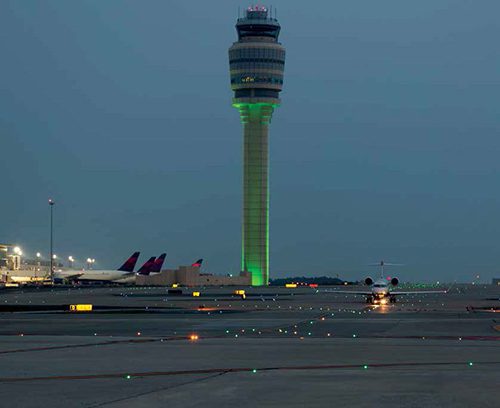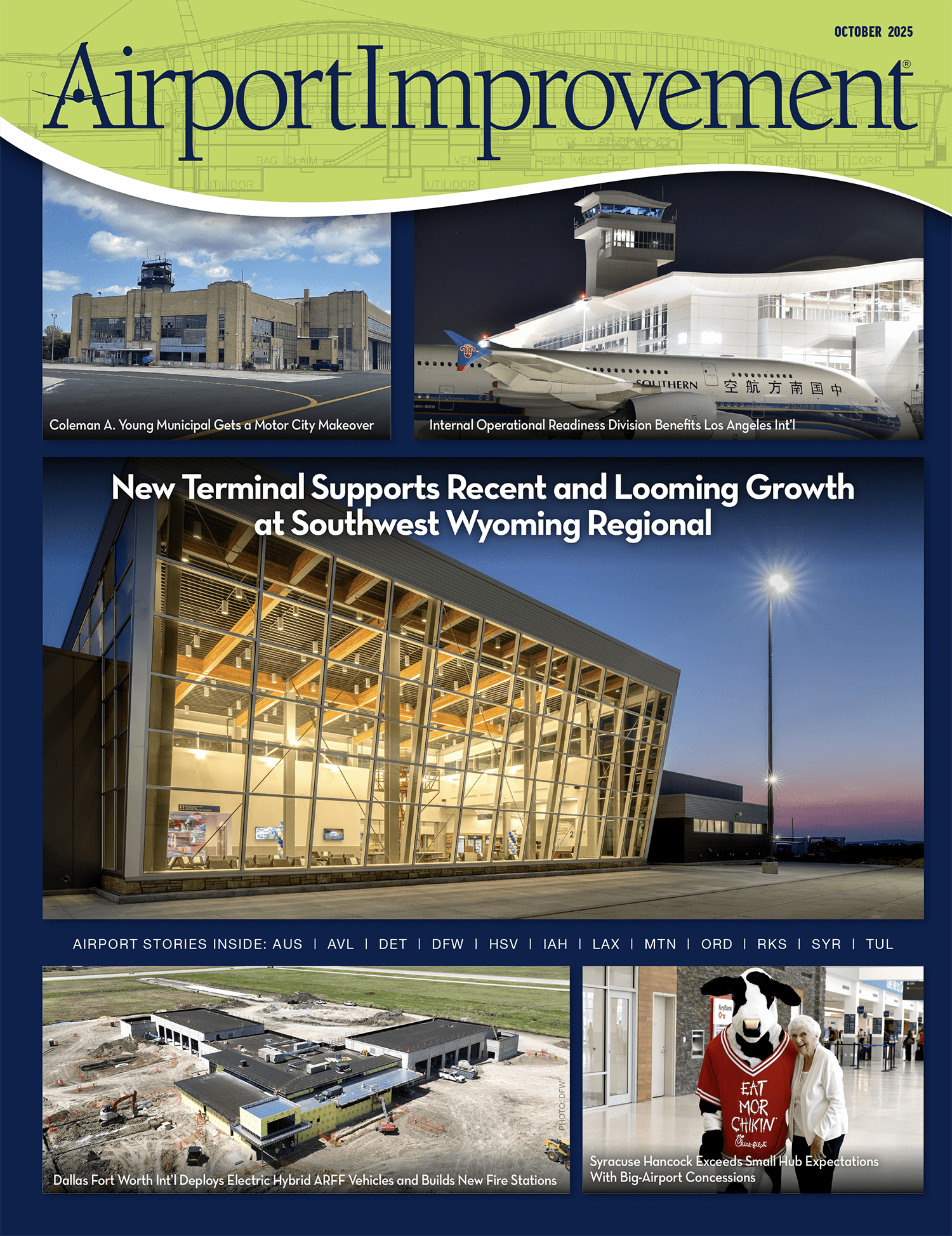Hartsfield-Jackson Atlanta International Airport (ATL) recently completed two massive projects to relight and remark its airfield. Almost all of the work occurred simultaneously, from March 2014 to July 2015. Together, the improvements cost the airport about $34 million – with no outside funding.
The nearly $16 million lighting project set a new precedent: “This is the first airport in the world to have all of its runways and taxiways lit with LED,” notes ATL Aviation Engineer Chris Rogers. “We take pride in being an industry leader.”
During the project, crews replaced all incandescent fixtures on four of the busy airport’s five runways, as well as lights on 11 taxiways and 52 taxiway exits. (LED lighting on Runway 8L-26R was part of a separate reconstruction project.) All told, the effort required approximately 13,000 LED fixtures.
 factsfigures factsfiguresProjects: Relighting & Remarking Airfield Location: Hartsfield-Jackson Atlanta Int’l Airport Scope: 4 of 5 runways, each 9,000-12,500 ft. long Lighting Project Markings Project |
Rogers characterizes the task of changing so many lights on an operational airfield the size of ATL’s as daunting. “Just finding a manufacturer that could produce and deliver the fixtures and a contractor with the workforce able to complete a project this large were major challenges,” he relates.
In retrospect, Rogers attributes the success of the project to great teamwork between the electrical contractor, manufacturers and airport.
The markings project was also labor-intensive. Contractors applied more than 2 million square feet of new paint and preformed thermoplastic markings throughout the airfield at a cost of approximately $18 million.
Chaim Van Prooyen, ATL’s project manager for the initiative, explains that a Part 139 inspection in 2012 inspired the project. “The FAA was very critical of the quality and condition of our airfield markings,” recalls Van Prooyen. “Repainting the entire airfield was too much for our internal resources to expedite the work, but we had to get it done; so we pursued and obtained airport funds to contract the work out.”
All LED
Phasing and scheduling were critical to maintaining safety during the lighting changeover, recalls Rogers. Before starting the project, airport management and staff met with FAA personnel and pilots to discuss the best way to schedule work in order to ensure safety. Because of the perception that LEDs emit a more intense illumination than incandescent lights, pilots requested that ATL install runway edge lights before centerline and touchdown zone lights to help establish the runway boundaries. They also asked for work to begin on the landing runways before the departure runways.
“The LED lights are very crisp and clean,” Rogers explains. “As we changed them out, we didn’t want to create a situation where we went from an older, existing incandescent fixture to a new crisp, clean LED light. That presented a challenge in terms of how we sequenced the work.”
ATL hired electrical contractor Brooks Berry Haynie & Associates to manage and perform the lighting changeover under a very tight schedule. Each runway took four or five nights to complete, depending on whether it included touchdown zone lighting.
In turn, each runway shut down at 11:30 p.m. and reopened at 6:30 a.m. On the first night, workers switched over the edge lights. On the second night, they installed the new centerline LEDs. On the third night, touchdown zone lights or high-speed exit lights were replaced, depending on the runway. Schedules for the fourth and fifth nights varied by runway, with personnel performing photometric testing or replacing high-speed exit lights and then performing photometric testing.
Jason Owen, president of the electrical contracting firm, describes scheduling the changeover as a major challenge. “We had our very best people out there and kept the same crew throughout the project,” he recalls. “Airfield lighting is very specialized work. Once you get people trained on it, you want to keep them around.”
At peak production, when crews had to swap out 360 touchdown zone lights in a single night, the company had about 20 people working on the runway. “With a liquidating damage charge of $500 for every minute the runway opened late, we wanted to make sure we had our ‘A team’ out there,” Owen says.
To facilitate the changeover process, workers spent approximately one week per runway checking every fixture. Broken bolts were replaced so that subsequent crews could swap out fixtures quickly and seamlessly.
Careful planning and completing preparatory tasks before closures began were key factors for success, notes Owen. “When we started work on the runways, every shelf on every single aisle in our 30,000-square-foot warehouse was filled with lighting fixtures,” he relates. “During the day, we had warehouse workers assembling fixtures, matching them with the proper transformer, making the connections and arranging them on a trailer so that workers on the field knew exactly where each fixture was and where it went at each location. Any work we could get done before the clock started ticking, we found a way to get it done.”
 After the 2,000 high-intensity runway lights were changed, workers began replacing 11,000 taxiway lights and 700 airfield guidance signs. The entire project required approximately 160,000 linear feet of new cable. Several constant current regulators were replaced, and other regulators were re-tapped to a lower kilowatt rating to increase power efficiency and save energy.
After the 2,000 high-intensity runway lights were changed, workers began replacing 11,000 taxiway lights and 700 airfield guidance signs. The entire project required approximately 160,000 linear feet of new cable. Several constant current regulators were replaced, and other regulators were re-tapped to a lower kilowatt rating to increase power efficiency and save energy.
“We are realizing a 75% energy savings on the runway LED lights and 55% on the taxiway lighting,” reports ATL Project Manager Kenneth Goggins. The savings have been so substantial that the Georgia Power Company awarded the airport rebates. “We are also looking for significant savings in maintenance costs going forward,” adds Goggins.
Like the contractor that installed the new LEDs, the company that manufactured the fixtures was stretched by the scope and timeline of the project.
“This was a very high visibility project for us, with significant liquidated damages if deadlines were not met,” reflects Joe Pokoj, president and chief executive officer of ADB Airfield Solutions, Americas. “Once the (runway) shutdown was scheduled, there was no changing it. We had to make sure we delivered all our product to the installing contractor prior to the shutdown, which involved making sure our supply chain could handle an order of this size while maintaining our regular business.”
 Working together, ATL management, the installation contractor and product suppliers completed the job ahead of the project’s original two-year schedule. “I challenged my guys to do the job in 18 months instead of 24 months. To show me up, they did in 13 months,” Owen relates.
Working together, ATL management, the installation contractor and product suppliers completed the job ahead of the project’s original two-year schedule. “I challenged my guys to do the job in 18 months instead of 24 months. To show me up, they did in 13 months,” Owen relates.
Markings Makeover
After the FAA came down hard on ATL for the general quality and condition of its airfield markings, the airport developed a comprehensive plan to remark its entire airfield. The new strategy included a distinct change in materials. In addition to repainting four of five runways, the airport opted to apply preformed thermoplastic markings on associated taxiways. (Markings on Runway 8L-26R were included in a separate project.)
Crews replaced almost all painted taxiway markings with a preformed thermoplastic product from Ennis-Flint. Chris Brooks, sales director for the company, recalls that ATL began testing the alternate material shortly after its 2012 markings audit. “Results were favorable and the airport began using AirMark (preformed thermoplastic) on several construction projects in 2013,” he relates. “It’s now used on approximately 80 taxiways as well as on non-movement areas.”
 The relative longevity of the two materials was a critical factor in the switch. “Preformed thermoplastic has an anticipated lifespan of 10 to 15 years, which is five to seven times longer than paint,” notes ATL’s Van Prooyen. “On average, we have to repaint every two years.”
The relative longevity of the two materials was a critical factor in the switch. “Preformed thermoplastic has an anticipated lifespan of 10 to 15 years, which is five to seven times longer than paint,” notes ATL’s Van Prooyen. “On average, we have to repaint every two years.”
The vast majority of taxiway markings were consequently converted to preformed thermoplastic: hold short bars and surface signs, movement boundaries, instrument landing system bars, geographical position markings, etc. Edge lines and centerlines are now the only taxiway markings that are painted at ATL. Although preformed thermoplastic can be used in such applications, the airport found it more cost-effective to continue painting those rigorously worn areas, explains Van Prooyen.
To expedite the markings project, planners divided it into four separate contracts so multiple contractors could overlap working as flight operation schedules permitted. The first contract began in March 2014 and the last concluded in July 2015.
 In total, about 1.8 million square feet of paint and 294,000 square feet of preformed thermoplastic markings were applied. Contractors completed approximately 70% of the work at night to minimize operational disruptions, but they worked during the day when nighttime temperatures were not conducive for product application – predominantly in early to mid-spring and mid- to
In total, about 1.8 million square feet of paint and 294,000 square feet of preformed thermoplastic markings were applied. Contractors completed approximately 70% of the work at night to minimize operational disruptions, but they worked during the day when nighttime temperatures were not conducive for product application – predominantly in early to mid-spring and mid- to
late fall.
“The scheduling process was our main challenge during the daytime hours,” recalls Van Pooyen. “When we finalized the contract, we collaborated with airport operations and the FAA to determine which daytime intersection closures would have the least impact on aircraft operations and proceeded in that direction until early April, when we were able to make the switch to nighttime work.”
Planners routinely took into account whether the airport was in east or west operations. “Because some intersections are utilized more than others, we didn’t want to inhibit traffic flow,” he explains.
On average, crews took two to three days to complete each intersection, which necessitated 10- to 12-hour daily closures. “We tried to give contractors a couple of options, so they would always have somewhere to work,” Van Pooyen remarks. “That was our main challenge during the daytime hours. When we switched to nighttime hours, we were given more leeway to close pavement, allowing contractors to increase productivity. At times, we were limited to closing only one runway at a time, which allowed other projects, such as the LED project, to run simultaneously. We also tried to follow behind other ongoing airfield work projects in order to have less impact on operations.”
Weather was an additional challenge, with considerable amounts of rain pushing back the schedule. The airport had originally hoped to complete the airfield project by June 2015, in time for its next Part 139 inspection, but didn’t finish until July.
With the comprehensive markings and lighting projects completed, Van Prooyen says the airfield looks 10 times better.




